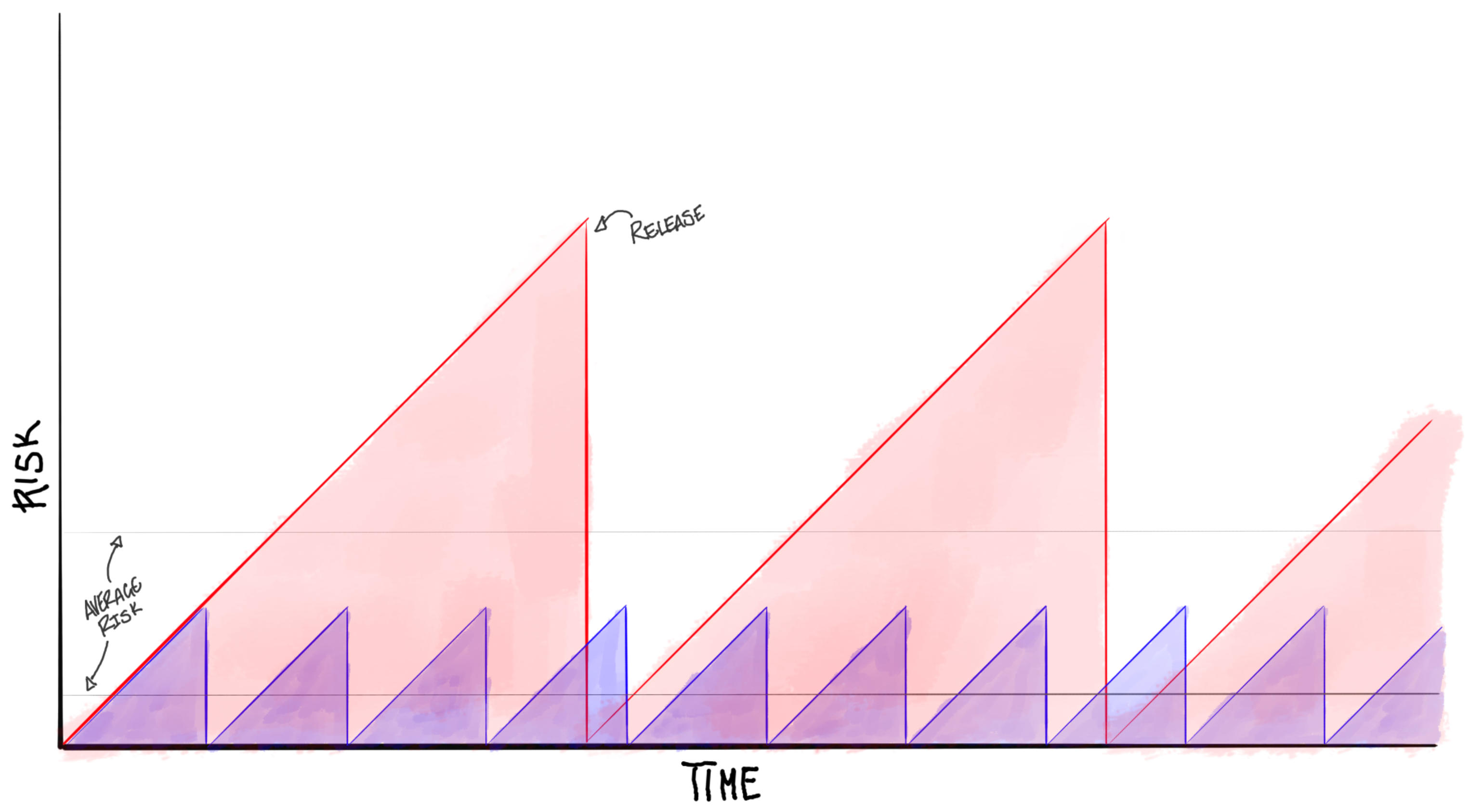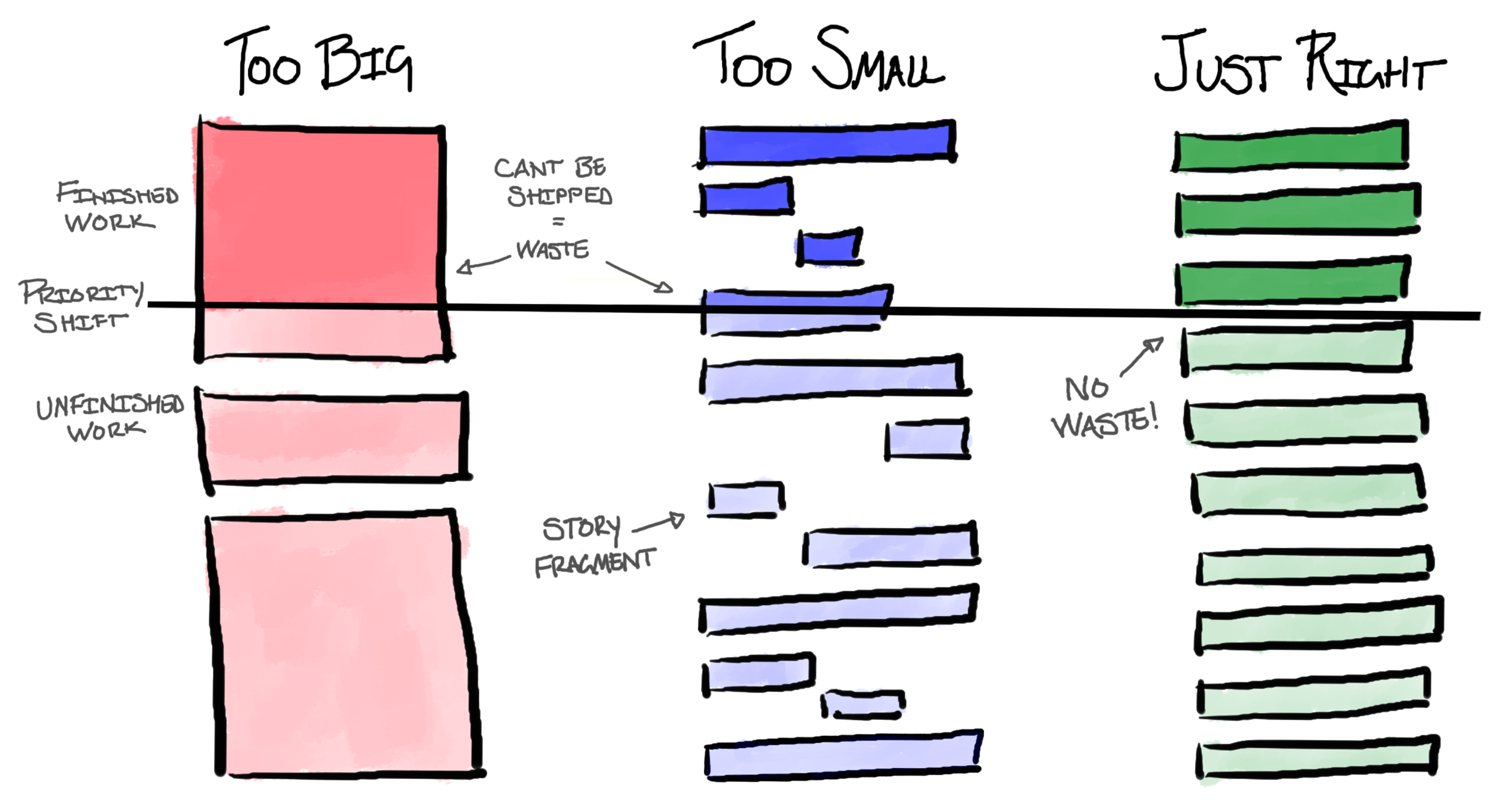# Agile in three drawings
Most agile transformations fail because teams adopt the rituals without understanding the underlying system.
The failure pattern is consistent. Executives mandate an agile transformation. Teams get trained on ceremonies and story points. Consultants install the latest overwrought tooling. Six months later, nothing has fundamentally changed except the vocabulary. Projects still take forever, quality is still inconsistent, and teams are still firefighting instead of building.
This happens because most organizations focus on changing their motions instead of changing their mindset. They memorize the agile manifesto but miss the core point: software development is not manufacturing, and trying to treat it like an assembly line that you can optimize sets you up to fail.
Three simple drawings explain why most transformations don't work—and what actually does work instead.
# The release paradox

At first blush, it feels like big releases should be safer because you can plan them better and test them more thoroughly. This baseline belief is so deeply embedded in most executives that questioning it feels heretical. But it's wrong, and the math proves it.
Large batches hide problems until it's expensive to fix them. Small batches surface problems when they're cheap to solve. This isn't some consultant hand waving agile methodology—it's just inventory economics applied to software.
In manufacturing, larger batches often reduce unit costs because you amortize setup costs across more units. Software development works in reverse. The "setup cost" for a release is mostly coordination and integration risk, which grows exponentially with batch size. Meanwhile, the marginal cost of adding one more feature to a release is near zero—until everything breaks.
This creates a vicious cycle. Large releases take longer to build, which increases the pressure to add "just one more feature" before shipping and the complexity of testing them. The larger release takes even longer, accumulating more risk and dependencies. When problems emerge—and they always do—the cost of fixing them is enormous because everything is interconnected.
Small, frequent releases break this cycle by limiting blast radius. A bug in a miniscule deployment might affect a day of work. A bug in a quarterly deployment can make you revert months of effort.
The economic principle is simple: optimize for recovery time, not prevention time. You can't prevent all problems, but you can control how quickly you detect and fix them.
# The planning delusion

The second failure mode is the belief that bigger bets with higher (outward) confidence can help you move faster. "All this testing is slowing us down, let's just build the thing we know is right!" This turns software development into elaborate theater where teams perform certainty for executives who demand it.
The planning delusion works like this: executives request yearly roadmaps with detailed estimates. Teams comply by breaking down features they've never built for users they've never met. Everyone pretends these numbers are meaningful. Twelve months later, when actual results bear no resemblance to the plan, everyone acts surprised, if they event look at the original incredibly detailed plans at all.
This isn't a failure of estimation—it's a failure to understand what estimation means in an environment with high uncertainty and rapid feedback loops.
Consider golf in heavy fog. You know the hole is roughly east, but you can't see more than 20 feet ahead. You have two club options: a driver that hits 200 yards, or a putter that moves you 10 feet at a time.
The driver looks more efficient. One swing covers serious ground and you know roughly the direction you want to go. But in fog, your 200 yard driver guarantees you'll end up far from your target. Every swing takes you 200 yards in a different direction.
The putter looks inefficient—all those small shots, all that time. But you're never more than 10 feet from where you're aiming. Each shot gives you new information about terrain and direction. You can adjust constantly.
Software development is golf in permanent fog. User needs shift, technology evolves, markets change. The landscape transforms while you're building. Big plans promise efficiency but deliver delusion. Small steps are slower in the short term but help you continually inch towards your goal.
The economic principle: in high-uncertainty environments, the cost of being wrong outweighs the benefits of speed. It's better to be a little slower but stay on course.
# The commitment trap

The third failure mode is optimizing for resource utilization instead of flow. This creates the illusion of efficiency while destroying actual productivity.
The commitment trap works like this: organizations break work into small pieces to maximize resource allocation. Eight engineers get assigned across four projects to ensure "full utilization." Project managers track hours across work streams to eliminate "idle time." Everyone stays busy, but nothing ships.
This approach treats human attention like manufacturing capacity. But attention isn't a machine that can switch between tasks costlessly. Context switching burns cognitive resources. Interruptions destroy flow states. Shared ownership dilutes accountability.
The economic principle is batch size applied to human attention. Too small, and you get thrashing. Too large, and you get inflexibility. The sweet spot is work packages that can be completed, tested, and shipped independently.
Good story sizing isn't about estimation—it's about minimizing coordination costs while preserving the ability to change direction. If priorities shift (and they always do), you want to minimize the amount of unshippable work in progress.
Stories should be like good investments: able to stand alone and create value independently, while fitting into a larger strategy. When work depends on other work to be valuable, you've created inventory that can't be shipped until everything else is ready.
The goal isn't keeping everyone maximally utilized. The goal is creating a continuous flow of value from idea to customer. These are not the same thing.
# The economic reality
These three principles aren't exclusive to agile. They're economic laws that apply whenever you're building something new with uncertainty.
Most agile transformations fail because they focus on process (standups, retros, points, velocity) instead of the fundamentals. Operating this way is like trying to improve a factory by giving everyone uniforms.
The best organizations don't just tack on agile ceremonies. They recognize that the ceremonies are just instantiations of some key principles (and that it's the principles that matter, not the process):
- →They optimize for learning speed, not resource utilization
- →They measure cycle time, not story points
- →They treat development as discovery, not production
- →They design for rapid feedback, not comprehensive planning
The transformation isn't about adopting frameworks. It's about accepting that software development is fundamentally different from other work and that you can't shoehorn product development into processes designed for different work.
Here's the contrarian truth: "agile" isn't a methodology you implement. It's what happens naturally when you organize teams around the economic realities of software development. The ceremonies and frameworks are just scaffolding—useful temporarily, but not the actual building.
Organizations that understand this become learning machines. They adapt to market changes before competitors recognize what's happening. In a world where software advantages compound, that's the only sustainable edge.